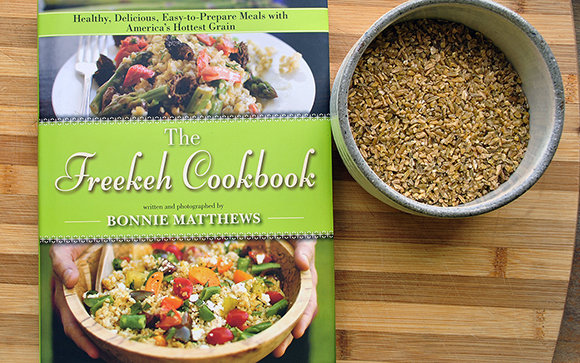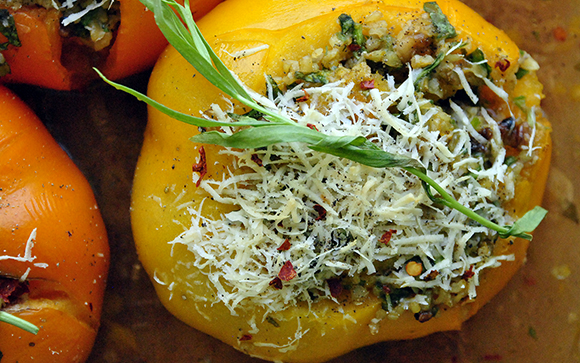
Here’s a typical weekday situation: A recipe calls for rice. There’s only 30 minutes for dinner. Healthy brown rice takes 45 minutes, and unhealthy white rice is 15 minutes to cook. When it comes to time, I’m guilty of choosing the latter. I have tricks for using grains in weekday meals, such as doubling the requested amount and storing the difference in the freezer, or cooking slow-cooking grains—such as barley and farro—on weekends.
One of my favorite healthy and quick-cooking grains is whole-wheat couscous. Quinoa is another favorite, but the rinsing process is time-consuming. My recent discovery is freekeh, a familiar grain in Arabic cuisines with a 15 to 20 minute cooking time.

It’s a grain that’s slowly becoming a part of America’s diverse cuisine, and it was introduce to me through Bonnie Matthews’ The Freekeh Cookbook. Matthews is a Southern gal, who woke up one morning and decided to make a healthy lifestyle change in her diet and exercise more. Along the way, she started working at Trader Joe’s as a food-demo cook. One of her favorite experimental ingredients was freekeh. Over time, Trader Joe’s stopped selling freekeh because of poor sales, but Matthews seized an opportunity and co-founded Freekeh Foods with Troy DeSmet.
Folklore explains that freekeh was discovered when a village was ransacked and crops of young, green wheat were burned. Disheartened villages didn’t give up. Instead, they rubbed off the burned parts of the stalks and saved the heads of the smoked grain—freekeh. The saved freekeh became the village’s first spring harvest offering.
Freekeh (or farik) in Arabic means “to rub.” During the burning process, the stalks and leaves are burned, but the seeds remain intact because of its high moisture content. The process is what gives the grain a slight smoky flavor with a chewy texture.
Freekeh is an easy substitute in most grain-based recipes. The Freekeh Cookbook offers recipes for incorporating the grain into American comfort food classics, such as Stir-Fry with Shrimp and Hoisin Sauce, Turkey and Freekeh Meatballs, and Banana Freekah Oatmeal Bread. My favorite is the recipe for Stuffed Heirloom Tomatoes, which is subtly flavored with tarragon. My version is below; I altered the recipe using fresh chopped baby spinach leaves, sprinkling a pinch of crushed red pepper with the salt and black pepper, toasting the nuts and using dry white wine instead of water at the bottom of the baking dish. Like I do with most grain recipes, I seasoned the freekeh’s boiling water with sea salt, fresh black pepper, a bay leaf and a drizzle of olive oil.
We fell in love with North African couscous and Central American quinoa. With globalization, varieties of grains from around the world are now a part of America’s cuisine. If freekeh hasn’t yet appeared in your grocery store, it’s coming soon—or you can get ahead of the food trend and order it online. Here’s your warning: you will love freekeh, not only for its slight smoky flavor and chewy texture, but because it’s such a convenient fast-food ingredient for weekday meals. White rice will no longer be a default.
Visit Parade.com to get the recipe for Bonnie Matthew’s Freekeh Stuffed Heirloom Tomatoes.

Hi, Angela! Speciality health food stories carry freekeh, and WholeFoods Brooklyn started selling it in their bulk section. The latter option is probably the cheapest cost. -sw
Sanura, Can you suggest where in NY I can find freekah? Sahadi’s probably?